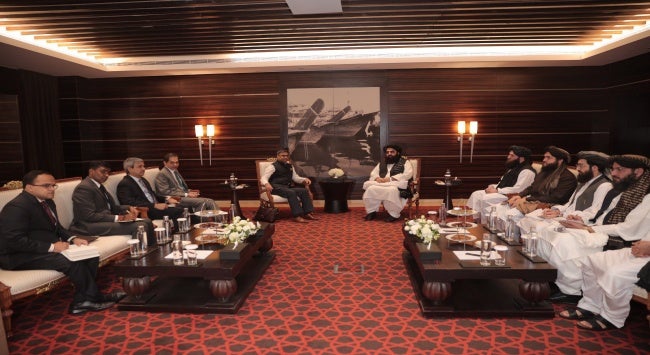Summary
India’s engagement with Afghanistan has focused on a strategic approach toward the Taliban. It has invested in infrastructure, provided humanitarian aid and maintained diplomatic channels while managing regional competition with China and Pakistan. While Afghanistan’s future remains uncertain under the Taliban’s rule, India’s sustained engagement aims to safeguard its interests and strengthen its regional influence.
India’s diplomatic relations with Afghanistan have evolved over time. In the past, these have been marked by key milestones such as the 1950 Treaty of Friendship and then Afghanistan’s President Mohammed Daoud Khan’s visit to India in 1975. In recent years, cultural initiatives such as the Indo-Afghanistan Friendship Series, launched in 2018, and evolving into cricket diplomacy have fostered broader international engagement and strengthened cross-cultural exchanges.
During the military intervention by the United States (US) in Afghanistan (2001–2021), India invested heavily in the country’s state institutions, including the construction of the Afghanistan parliament as well as training its military. These efforts, however, collapsed with the Taliban’s returned to power in 2021, prompting India to recalibrate its foreign policy. While it did not officially recognise the Taliban, India remains among 40 nations that maintain diplomatic ties with the country. In December 2021, India sent humanitarian aid to lay the groundwork for engagement. In January 2024, Indian diplomats met Afghanistan’s Foreign Minister Amir Khan Muttaqi to discuss infrastructure rebuilding, followed by a meeting between Indian Foreign Secretary Vikram Misri and Muttaqi in Dubai in January 2025. The meeting was concluded with the Indian foreign ministry aiming to bolster trade and development projects in Afghanistan. The Taliban government stated that “the Islamic Emirate aims to strengthen political and economic ties with India as a significant regional and economic partner.”
India’s focus on Afghanistan aligns with the region’s evolving dynamics. China has intensified its involvement, appointing an ambassador, Zhao Xing, to Afghanistan and expressing interest in investing in the country’s natural resources such as copper, lithium and gold deposits estimated to be worth US$1 trillion (S$1.342 trillion). These resources and access to the country are expected to support China’s Belt and Road Initiative (BRI). In response, India aims to counterbalance China’s influence by strengthening its ties with Afghanistan and leveraging this growing relationship to navigate its historically complex ties with Pakistan. As of 2023, it is reported that India has undertaken more than 500 projects across all 34 Afghan provinces, focusing on essential sectors such as energy, water infrastructure, transport, healthcare, education, agriculture and capacity building. India currently has a trade deficit with Afghanistan, importing US$642.29 million (S$862.4 million) worth of items, comprising mainly nuts, fruits and spices, and exporting products amounting to US$355.45 million (S$477.3 million), consisting primarily medicines, vaccines, soybean meal and garments in 2023-24.
Although Pakistan is one of the few countries that have sympathised with the Taliban, their relationship remains complex. When the US left Kabul, Pakistan’s then Interior Minister Sheikh Rasheed Ahmed announced that over time, with Afghanistan’s growth, the region would acquire global significance. While presumably, the Taliban would be Pakistan’s natural ally, they have been less cooperative than anticipated, with the former focusing instead on a nationalist rhetoric to unite Afghans. Additionally, terrorist attacks in Pakistan have increased 70 per cent from 2023 to 2024 which resulted in nearly 2,000 casualties. According to the Pakistan Institute for Peace Studies, much of the blame can be attributed to the Tehreek-e-Taliban Pakistan, the Pakistan faction of the Taliban. While Pakistan’s Prime Minister Shehbaz Sharif has strongly condemned the attacks, longstanding disagreements on the ‘Durand Line’, a border inherited from the colonial era, also add to ongoing tensions.
Historically, Pakistan maintained an ‘Afghan policy’ that involved balancing its relations with India, while India and Afghanistan have also engaged in strategic hedging to manage their ties with Pakistan. A key element of India’s strategy is the Chabahar Port Project in Iran, which serves as a counter to China’s BRI. The port is integral to the North-South Transport Corridor and offers an alternative trade route connecting India to Central Asia, Europe and Russia. This enhances regional connectivity while reducing India’s reliance on Pakistan for access to Afghanistan.
While China has offered tariff-free trade to the Taliban bolster its construction, energy and consumer sectors, Afghanistan seeks to capitalise on this partnership by attracting foreign investment and generating revenue from its rich mineral resources, which, in turn, is said to support China’s battery, construction and supply chain industries. Growing trade interdependence and opportunities for development indicate the possibility of a shift in the country’s trajectory, yet it remains uncertain just how the Taliban’s vision of the Islamic Emirate, focused on strict social control, may impact or impede opportunities for international trade and diplomacy.
More broadly, Afghanistan’s global integration remains uncertain but its engagement with international forums is increasing. In June 2024, the United Nations held its third round of talks on Afghanistan’s future, with the Taliban participating for the first time. While this engagement raises hopes for improving the country’s prospects, the Taliban’s commitment to international obligations and human rights principles over its ideological agenda stands as an enduring question mark. For India, Afghanistan’s future carries significant implications. New Delhi’s strategic investments and diplomatic efforts showcase its intent to play an important role in shaping Afghanistan’s future and the broader regional order.
. . . . .
Dr Imran Ahmed is a Research Fellow at the Institute of South Asian Studies (ISAS), an autonomous research institute at the National University of Singapore (NUS). He can be contacted at iahmed@nus.edu.sg. Ms Tanujja Dadlani is a Research Analyst at the same institute. She can be contacted at tanujjad@nus.edu.sg. The authors bear full responsibility for the facts cited and opinions expressed in this paper.
Pic Credit: X
-
 More From :
More From :
-
 Tags :
Tags :
-
 Download PDF
Download PDF



